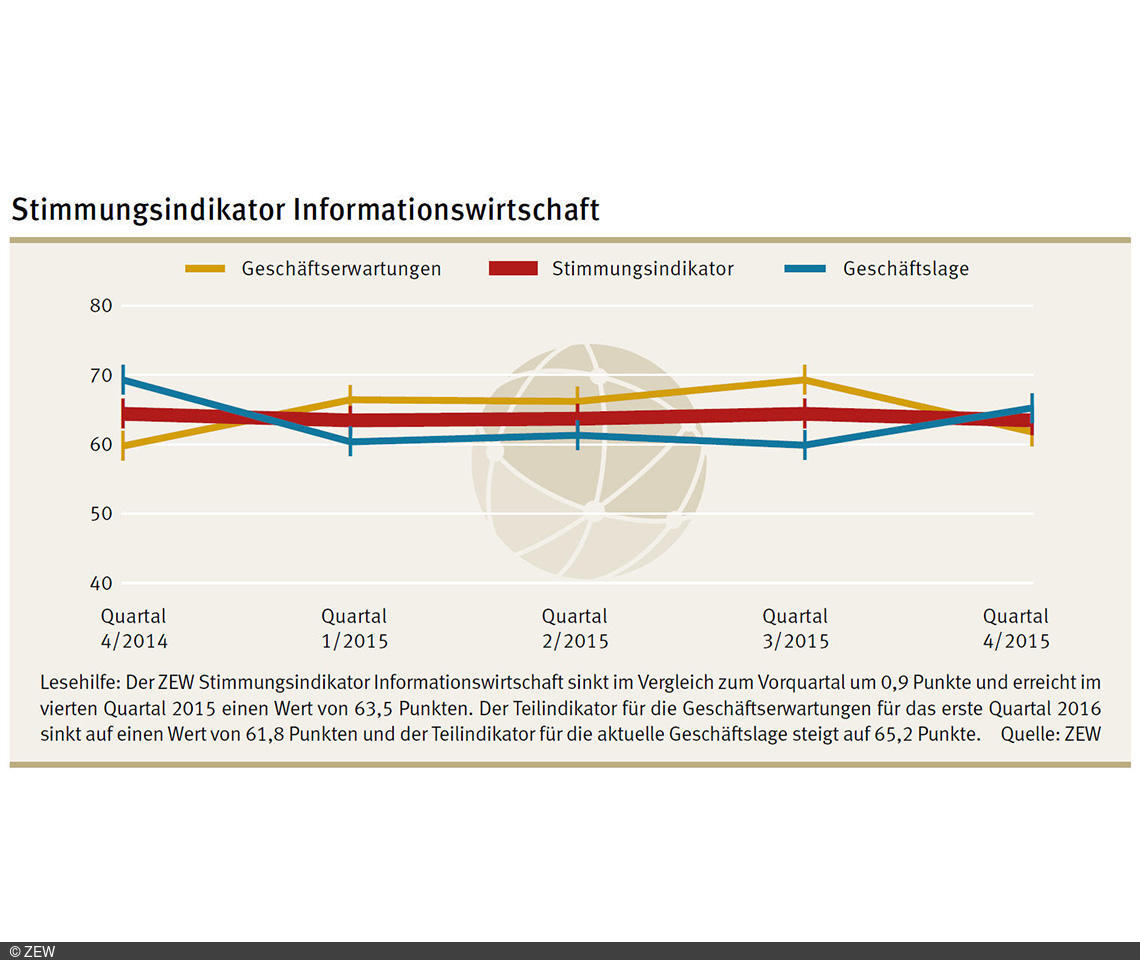German Information Economy - ICT Sector Enters New Year with Optimism
Information EconomyThe economic sentiment among businesses in the German information economy is favourable at the moment, as suggested by the ZEW Economic Sentiment Indicator for the Information Economy. The indicator stands at a level of 63.5 points and thus remains above the crucial 50-point mark. Despite a slight decline by about one point, the majority of companies positively asses both their current business situation and the economic outlook for the first quarter of 2016. This is the result of a survey conducted by the Centre for European Economic Research (ZEW) in December 2015 within the information economy.
In the fourth quarter of 2015, the sentiment indicator for the entire information economy sector remains at a constant high level and has merely dropped by about one point compared to the previous quarter. This slight setback can be attributed to the unfavourable development of business expectations outweighing the improvement of the current business situation. The sub-indicator for the business situation has increased by 5.3 points compared to the previous quarter, climbing to a reading of 65.2 points. The sub-indicator for business expectations has fallen to a level of 61.8 points. Despite having dropped by 7.5 points compared to the previous quarter, the sub-indicator still ranges far above the 50-point mark, signalling a positive economic development for the first quarter of 2016.
The information economy sector consists of the sub-sectors information and communication technologies (ICT), media service providers, and knowledge-intensive service providers. The economic sentiment among companies in the ICT sector has brightened up again in the fourth quarter of 2015. The indicator maintained its high level from the previous quarter and continued its growth by climbing an extra 3.9 points, reaching a total of 72.6 points. This growth has been driven by the companies’ positive assessment of the business situation, with the corresponding sub-indicator reaching a level of 73.7 points. This corresponds to a rise of 12.5 points compared to the previous quarter. By contrast, the sub-indicator for business expectations has lost 5.6 points and closes at 71.6 points. The fact that the sub-indicator is at such a high level implies, however, that the majority of businesses expect both turnovers and demand to increase in the first quarter of 2016.
The economic sentiment in the media sector has declined significantly in the fourth quarter of 2015. After the majority of media service providers had been optimistic in the previous two quarters, the sentiment indicator has now again fallen below the crucial 50-point mark. The indicator has dropped by 11.5 points compared to the previous quarter, falling to a reading of 49.4 points. The decline can be attributed to the negative development of both business situation and business expectations. The sub-indicator for the business situation falls from 6.2 to 48 points. The sub-indicator for business expectations has decreased considerably by 17.7 points to 50.8 points.
The economic sentiment among knowledge-intensive service providers is favourable at the moment. Despite the sentiment indicator having lost almost two points, it still remains on a relatively high level. The level of 59.9 points indicates that most businesses predominantly assess positively both their current situation and their future economic expectations. The sub-indicator for the business situation has even increased compared to the previous quarter, reaching a total of 62.7 points. On balance, about one quarter of businesses could increase their turnovers or the demand for their services. The business situation has improved especially for businesses operating in the advertising industry and in market research. By contrast, business expectations are less positive than in the previous quarter. The corresponding sub-indicator has dropped to 57.2 points. However, the majority of the businesses expect the economic situation to improve in the first quarter of 2016.
For more information please contact
Daniel Erdsiek, Phone +49(0)621/1235-356, E-mail erdsiek@zew.de
The Economic Sentiment Indicator for the Information Economy
The Economic Sentiment Indicator for the Information Economy is composed of the four components sales situation, demand situation, sales expectations and demand expectations (each in comparison with the previous and following quarter). They are equally taken into account for the calculations. The sales situation and the demand situation form a sub-indicator reflecting the business situation. Sales expectations and demand expectations form a sub-indicator reflecting the business expectations. The geometrical mean of the business situation and the business expectations is the value of the Economic Sentiment Indicator in the Information Economy. The sentiment indicator can take on values from 0 to100. Values above 50 indicate an improved economic sentiment compared to the previous quarter, values smaller than 50 indicate deterioration compared to the previous quarter.
The economic survey conducted by ZEW
About 5,000 businesses with a minimum of five employees participate in the quarterly survey conducted by ZEW. The companies surveyed belong to the following business sectors: (1) ICT hardware, (2) ICT service providers, (3) media, (4) law and tax consultancy, accounting, (5) public relations and business consultancy, (6) architectural and engineering offices, technical, physical and chemical analysis, (7) research and development, (8) advertising industry and market research, (9) other freelance, academic and technical activities. Combined, all nine sectors make up the economic sector of the information economy. The ICT sector consists of ICT hardware and ICT service providers. Sectors three to nine make up the knowledge-intensive service providers. Overview of the ZEW economy survey (in German) at www.zew.de/konjunktur.
